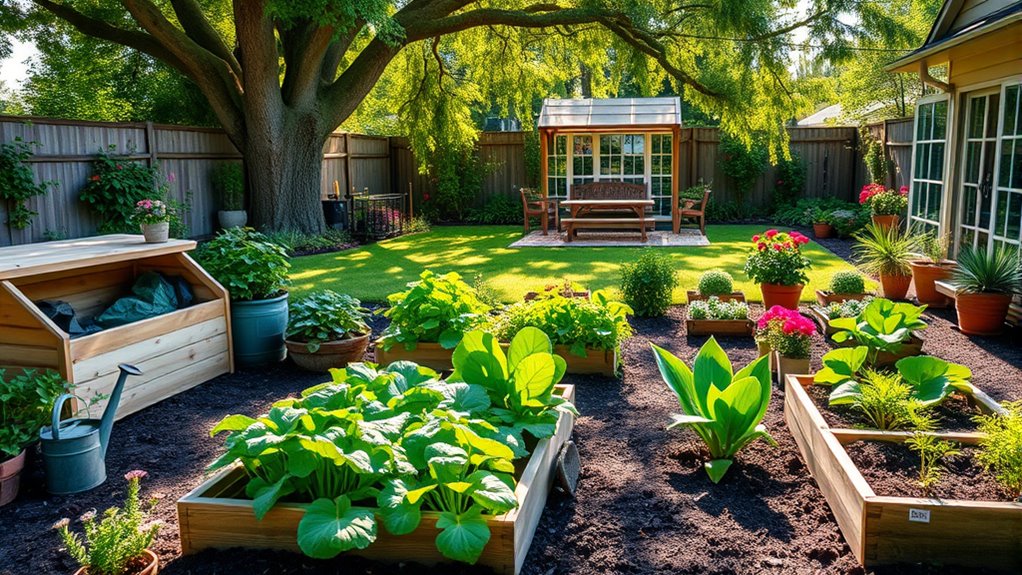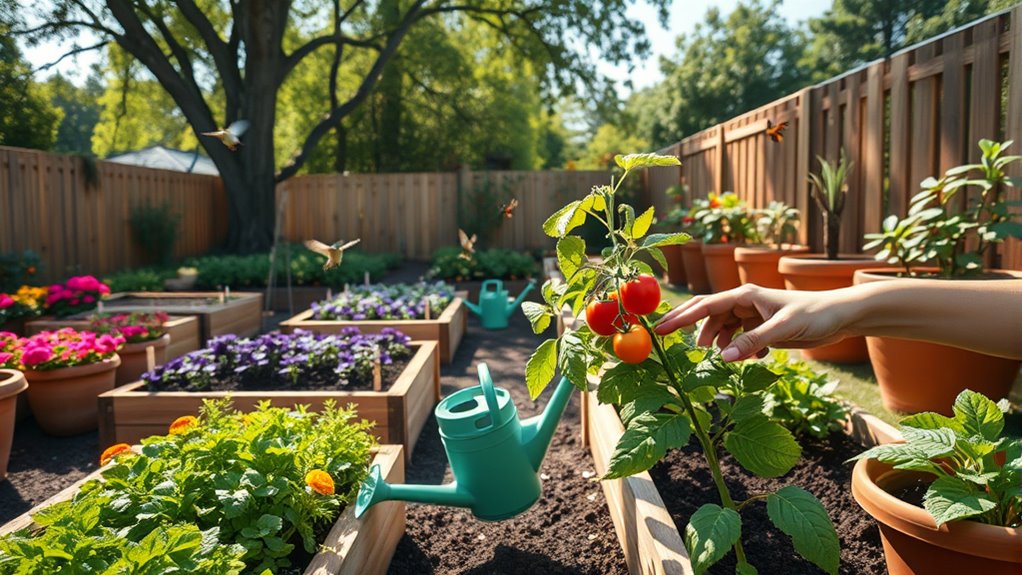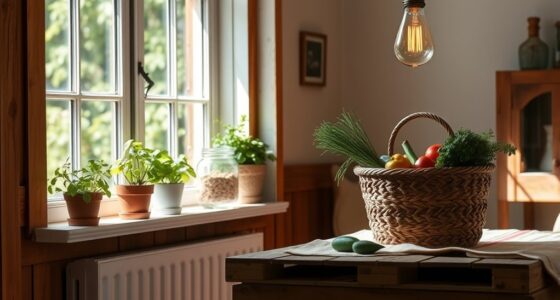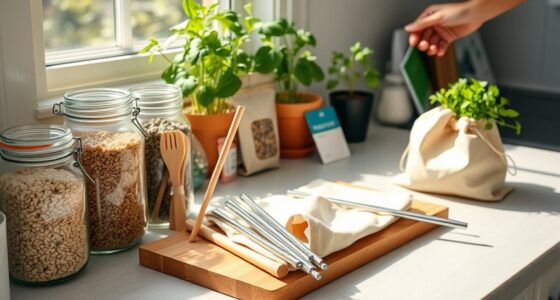Starting a thriving backyard garden is simple when you focus on basic soil prep, like clearing weeds, loosening the earth, and adding compost to boost fertility. Use plant pairings, such as basil with tomatoes, to naturally repel pests, and follow proper spacing and watering routines. Mulching helps retain moisture and reduce weeds. Don’t forget to monitor your plants regularly—soon, you’ll see how these easy steps make gardening manageable for anyone, even without prior experience.
Key Takeaways
- Prepare your soil by clearing weeds and adding compost to improve fertility and drainage.
- Use companion planting, like basil with tomatoes and marigolds around vegetables, to naturally deter pests.
- Start with small containers or raised beds to learn and manage gardening easily.
- Position taller plants away from shorter ones to ensure proper sunlight and avoid shading.
- Incorporate sound vibrations and regular maintenance to boost plant health and resilience.

Starting a backyard garden is a rewarding way to enjoy fresh produce and connect with nature. You don’t need a green thumb to create a thriving space—just a little planning and some basic knowledge. One of the best ways to set yourself up for success is through proper soil preparation. Healthy, well-prepared soil forms the foundation for strong plants and bountiful harvests. Start by clearing the area of weeds, rocks, and debris. Then, loosen the soil with a garden fork or tiller, allowing roots to penetrate easily. Incorporate organic matter like compost or aged manure to improve soil fertility and drainage. This not only supplies essential nutrients but also boosts beneficial microorganisms that support plant health. Testing your soil’s pH can also help you make adjustments if needed, ensuring your plants thrive in an ideal environment. Additionally, understanding sound vibrations and their influence on plant growth can further enhance your gardening success.
Once your soil is prepared, consider the concept of companion planting. This technique involves pairing certain plants together to enhance growth, deter pests, and improve flavor. For example, planting basil near tomatoes can help repel insects, while marigolds can deter nematodes and other pests from a variety of vegetables. Companion planting is an easy, natural way to protect your garden without resorting to chemicals, making your garden more sustainable and enjoyable. It also encourages biodiversity, which strengthens the overall health of your garden ecosystem.
When you’re ready to plant, focus on placement. Position taller plants like corn or trellised beans where they won’t shade shorter crops such as lettuce or radishes. Make sure to follow spacing guidelines to prevent overcrowding, which can lead to poor air circulation and disease. Regularly watering your garden is essential, especially after planting, to help roots establish. Mulching around plants helps retain moisture, regulate soil temperature, and suppress weeds. Keep an eye on your plants’ progress and watch for signs of pests or diseases, addressing issues early before they become major problems.
Starting small with a few containers or a modest bed allows you to learn and adapt as you go. As you gain confidence, expand your garden gradually, experimenting with different plant combinations and techniques like companion planting. Remember, patience is key. Your garden will improve over time, especially when you pay attention to soil preparation and make strategic plant pairings. With these simple steps, you’ll create a healthy, productive backyard garden that’s both enjoyable and sustainable, even if you’re just beginning your gardening journey.
Frequently Asked Questions
What Are the Easiest Plants for Beginners?
If you’re new to gardening, start with easy plants like lettuce, radishes, and herbs such as basil and mint. These plants thrive with minimal fuss and benefit from companion planting, which can help protect them naturally. Proper soil preparation is key—make sure to enrich your soil before planting, and you’ll see quick growth. These simple steps boost your confidence and make gardening enjoyable, even if you’re just beginning.
How Often Should I Water My Garden?
Like a gentle river flowing, your garden needs consistent care. For ideal garden hydration, water your plants early in the morning or late in the afternoon. Stick to a regular watering schedule, typically every 2-3 days, but adjust based on weather and soil. Keep the soil moist but not soaked, ensuring your plants thrive without drowning. Proper watering helps your garden flourish, even if you’re new to gardening.
Do I Need to Fertilize Regularly?
You should fertilize regularly to keep your garden healthy. Start by testing your soil to understand its nutrient levels through soil testing. Incorporate composting techniques to enrich your soil naturally, providing essential nutrients without overdoing it. This helps your plants grow strong and vibrant. Regular fertilization, combined with compost and soil testing, guarantees your garden receives the right nutrients, making it thrive with minimal effort.
How Do I Prevent Pests Naturally?
To prevent pests naturally, you should practice companion planting, which involves growing certain plants together to deter pests. You can also use natural repellents like neem oil or garlic spray to keep unwanted visitors away. Keep your garden healthy by attracting beneficial insects like ladybugs and lacewings, which prey on pests. Regularly inspect your plants and remove any pests or affected leaves promptly to maintain a thriving, pest-free backyard garden.
What Is the Best Time to Plant Outdoors?
Did you know that planting at the right time can boost your garden’s success by up to 50%? You should plant outdoors after your last frost date, which varies with your local climate. Before planting, focus on soil preparation—enrich it with compost and ensure proper drainage. Check local planting calendars to time your planting perfectly, giving your garden the best start and ensuring healthy growth throughout the season.
Conclusion
Now, picture your backyard bursting with vibrant vegetables and colorful blooms, sunlight dancing on lush leaves. With a little effort, you’ll watch your garden grow, filling the air with fresh scents and lively sounds. No green thumb needed—just patience and passion. As you nurture each plant, you’ll create a personal oasis where nature flourishes, and your efforts turn into a thriving, beautiful haven right outside your door. Your garden dream is well within reach.









